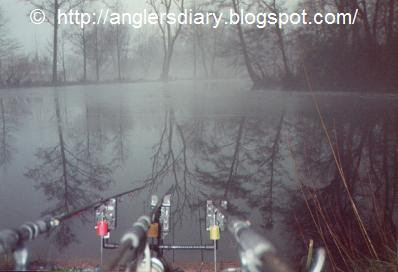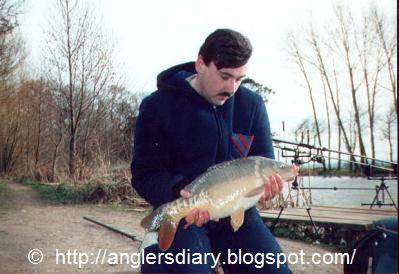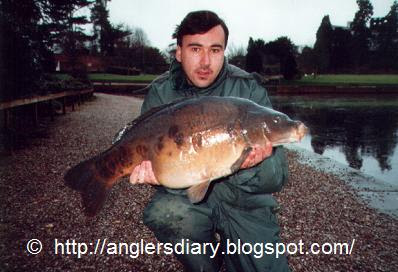Locating Winter Carp
I’ve fished for carp in winter for the last 17 years or so now. Depending on the water I fish, I can sometimes catch more carp in winter than I do in summer. Obviously having access to a well stocked carp lake helps but even on a productive winter carp water, locating the carp is still everything when it comes to catching a fish at this time of year.
Looking back at the time I’ve spent carp fishing in winter, I’d have to say the best advice I can give is to throw away the rule book. Yes it’s true the fishing is harder, the carps metabolism does slow down and generally they become less active but when it comes to the most important part, actually finding them, the bottom line is they will be where they will be. I’ve found carp in so many different places in winter, shallow water, deep water, off the bottom, on the back of the wind, in the teeth of an icy wind, they can be just about anywhere but they absolutley have to be found in order to catch consistently when its cold.
The only way to find the carp is to get out there and get fishing. By far the best pointer to getting a bait on the fish is actually spotting them moving. If you see a fish roll or jump during the winter months then get on it straight away. If you just sit there and do nothing when a carp shows then you deserve to blank. Personally, I’m usually already getting my gear together ready for a move before the ripple of a crashing fish has disappeared. That one fish showing can sometimes be the key to finding an area the carp hold up in so ignore it at your peril!.

With no carp sighted things get a lot harder. This is where water craft and previous experience comes in. Myself, I’ve found that carp will nearly always hold up in an area they feel safe and in most cases that will be around some kind of feature. That’s not really rocket science is it? Any feature is a potential carp holding area in winter and as such should be fished a few times before being discounted. In my own fishing, I tend to arrange features into a certain order in my head then fish them in turn, the order in which I fish any features is purely down to experience, the features I’ve found carp around the most in winter are the ones I fish first.
Snags
If the lake I’m fishing has any kind of snags at all, these will be the first areas I’ll look at and fish. Carp love snaggy areas and it’s not uncommon to find the fish stacked up against and round say, a fallen tree for example. One of the best examples of carp stacked up around snags is Cheshire carp water bolesworth castle on the stoke on trent card. During the winter months the carp hold up against the willow tree snags that are opposite the first swim in the field at the end of the woods. The first time I found the carp there I had 4 double takes (both rods off at the same time) in the first hour landing all 8 fish. Finding the carp and being first to cash in on fishing their holding area, the action I had in that swim was frantic to say the least. I fished short day sessions from midday until 4pm in that swim and during the winter I averaged 5 fish per session until I was caught playing a fish by a fellow member, once word got out the swim was never the same although you’ll still catch from it today.

Dead Lily Pads
After snags, dead lily pads would be my next choice for finding winter carp. I’ve seen it written that dead lily beds offer the carp a bit more warmth, a sort of insulation if you like. I’m not entirely sure that’s true, having never taken the water temperature in such areas I wouldn’t like to say if the ‘more warmth’ theory is right or wrong, either way, dead lily pads can be exceptionally good holding areas and are well worth checking out during the winter months. One lake where dead lily pads used to produce carp in winter is former day ticket carp water burton mere. The extensive lily pads at the house end of the mere often held carp during the colder months and it was here that I caught my first ‘winter 20' on the 3rd January 1994, just an hour after the lake had thawed out.


Dead Weedbeds
Similar to and of equal importance as dead lily pads, if there are dead weedbeds on your lake these areas are well worth investigating and sooner rather than later when you’re looking at locating winter carp. On one little known north west carp water I used to fish, there was a small weedbed in one area of the lake and it was here I quickly located what turned out to be just about every carp in the lake. This particular dead weedbed never failed to produce and I banked the lakes largest inhabitant along with all his mates, all between late November and early march one winter. The weedbed was like a magnate for the fish and no matter what the conditions the carp where always in or around it.

Dead Reed Beds
Again similar to lily pads and weedbeds, areas of dead reeds can quite often hold carp and if they are present on your lake they should be investigated. There was a small bed of reeds on burton mere water woodland pool, the carp hung around the reeds during the winter and runs would come from reedbed like clockwork, I remember it was a standing joke between me and my mate, whoever had a rod on the reedbed would catch a fish at exactly 13.05pm!. Run time was so predictable I once stopped an angler in mid conversation, tapped my watch and said 'sorry mate, its run time and the left hand rod is about to go!'. With that, the left hand rod duly rattled off and the look on the poor guys face was a picture!. It was just one of those funny moments in fishing and it proved that carp can sometimes be very easy to catch in winter, once you know where to put your baits.

Overhanging Trees
You usually associate overhanging trees with margin swims and it applies to both lake and island margins. Trees overhanging the water can provide cover and shelter for carp and after snags, lily pads, weedbeds and reed beds, overhanging trees would be the next feature I’d investigate. One such water where overhanging trees can produce carp is famous north west carp water capesthorne hall. Capesthorne hall main lake might be a very well known carp water but what isn’t so well known are the areas that can produce carp in winter. One of the very best areas for catching a winter carp on capesthorne main lake is a swim known as the plug hole. There are trees overhanging the water opposite the plug hole and baits positioned under these trees can produce carp during the winter months. Runs don’t come along every session as it’s not the easiest of waters. However, if you can get some time in the plughole swim you have a great chance of bagging yourself a real winter whacker.

In the absence of any of the above features to investigate I usually start fishing on the back of the wind, not only is it more comfortable during the winter months, it enables you to set up in such a way as to be able to see most of the lake. With none of the above features to go on I’ll get myself comfortable and watch the water for signs of carp. In the winter months this requires a lot of concentration which is why I prefer short intense fishing sessions during the colder months. I don’t enjoy being bivvy bound at this time of year and I think you work harder when you’re on limited time.
There is always the marker rod if you’re prepared to sacrifice a session or two, unseen underwater features are just as likely to be winter carp holding areas as the features I’ve outlined above. Remember, the carp will be where they feel safe and only the carp themselves can decide where that is. Personally, I think a marker rod is vastly over rated. I’ve been in the fortunate position of seeing a couple of north west carp lakes emptied of water and the bottom was nothing like the impression I had from the marker. With this in mind, I no longer bother feature finding with a marker rod, I do have one but I only use it for baiting up open water swims accurately. As a feature finding tool I think marker rods are rubbish and I much prefer to let the carp show me where they are prepared to feed, even in winter.
In order to catch carp in winter you really just have to get out there and do it, on one particular 16 acre sand pit I eventually pinned the carp down to a shallow area barely 2 feet deep. The pit had been a working sand pit and when it was flooded things were left behind. In the area I found the carp I would occasionally get my hook caught on some rotting wood. Bits of this wood came in on the hook now and again and it was the only feature in the area. Despite the water being shallow, there would be carp round this feature constantly and I only found it by being there and watching the water constantly over a few short sessions.
On my current winter water, the margins and shallows are superb in summer but during the winter, the carp prefer deeper water. Although the lake is pretty featureless, all the areas I’ve caught consistently from in winter do have one thing in common. I regularly retrieve bloodworm on the Hook

Sometimes locating winter carp can be a long and painful process, particularly if your chosen water has a low stock of fish. You won’t catch anything sat at home though. Keep watching the water and move on a showing fish straight away. If you can’t find them then start investigating the features in the lake one by one whilst keeping your eyes peeled for showing fish, not just rolling and crashing fish but bubblers too, if you see signs of bubbling then keep an eye on the area, if its gas, the bubbles won’t move but if its fish you can expect to see maybe a small amount of movement as the carp grub about on the bottom. If you’re not sure then investigate it with a rod anyway, sometimes you can just stumble across a productive winter hotspot by accident, if you don’t try the area or go with your hunch you’ll never know.
To give a rough idea about my own mindset when it comes to winter carp location, I'm quite happy to accept that when I fish a new water in winter, it might be the winter after before I manage to pin down a holding area and start getting my rewards, sometimes you can get lucky and find carp easily but I always expect it to be a long and drawn out process of elimination as I search different areas and continually look for the fish.
Finally, and for the lazy tossers out there, other anglers can be a help in winter, if you’ve no idea where the carp are and you see someone else catch then it can pay to keep an eye on the area they are fishing and what they are doing. I’m not very comfortable about using this method to get on the carp in winter but the way the north west carp scene is, most anglers would jump in your grave for the chance of catching a fish. I've been stung a few times in the past when other anglers have stumbled accross me playing a fish then jumped on my hard work so I now operate on the ‘do unto others as they do to you’ principle, not very nice I know but all’s fair when it comes down to locating winter carp!.
Tight Lines.
Mark.
Nice article. Would agree with your winter findings. One thing I didn't see mentioned is Bait. I think heavy baiting in winter is the kiss of death. I always found a little when not fishing and nothing when fishing worked best for me.
ReplyDeleteCheers mickey, it was only about finding them. I'm with you on the bait though, I've always found heavy baiting the kiss of death in winter too, strange how bait companies keep pushing it though!.
ReplyDeleteBang on as always mark I think zigs in winter can also be a deadly tactics tho
ReplyDeleteagreed 100% mate, i did very well on zigs last winter and they've definitely found a place in my winter fishing. i'll do some content on zig fishing at some point in the future for sure.
ReplyDelete